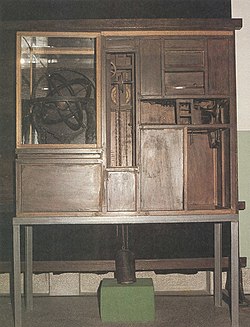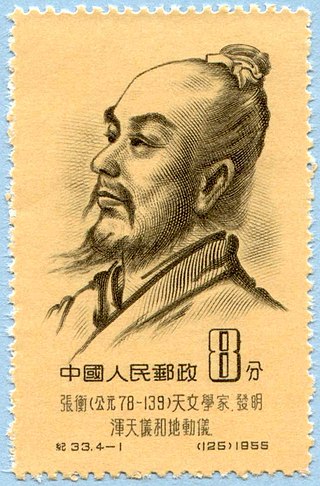
Zhang Heng, formerly romanized as Chang Heng, was a Chinese polymathic scientist and statesman who lived during the Han dynasty. Educated in the capital cities of Luoyang and Chang'an, he achieved success as an astronomer, mathematician, seismologist, hydraulic engineer, inventor, geographer, cartographer, ethnographer, artist, poet, philosopher, politician, and literary scholar.

An orrery is a mechanical model of the Solar System that illustrates or predicts the relative positions and motions of the planets and moons, usually according to the heliocentric model. It may also represent the relative sizes of these bodies; however, since accurate scaling is often not practical due to the actual large ratio differences, a subdued approximation may be used instead. Though the Greeks had working planetaria, the first orrery that was a planetarium of the modern era was produced in 1713, and one was presented to Charles Boyle, 4th Earl of Orrery – hence the name. They are typically driven by a clockwork mechanism with a globe representing the Sun at the centre, and with a planet at the end of each of the arms.

An astrolabe is an astronomical instrument dating back to ancient times. It serves as a star chart and physical model of visible heavenly bodies. Its various functions also make it an elaborate inclinometer and an analog calculation device capable of working out several kinds of problems in astronomy. In its simplest form it is a metal disc with a pattern of wires, cutouts, and perforations that allows a user to calculate astronomical positions precisely. Historically used by astronomers, it is able to measure the altitude above the horizon of a celestial body, day or night; it can be used to identify stars or planets, to determine local latitude given local time, to survey, or to triangulate. It was used in classical antiquity, the Islamic Golden Age, the European Middle Ages and the Age of Discovery for all these purposes.

Clockwork refers to the inner workings of either mechanical devices called clocks and watches or other mechanisms that work similarly, using a series of gears driven by a spring or weight.
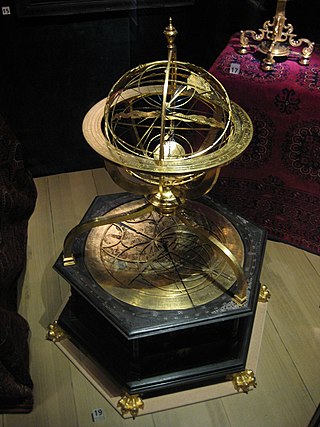
An armillary sphere is a model of objects in the sky, consisting of a spherical framework of rings, centered on Earth or the Sun, that represent lines of celestial longitude and latitude and other astronomically important features, such as the ecliptic. As such, it differs from a celestial globe, which is a smooth sphere whose principal purpose is to map the constellations. It was invented separately first in ancient China during the 4th century BC and ancient Greece during the 3rd century BC, with later uses in the Islamic world and Medieval Europe.

A water clock or clepsydra is a timepiece by which time is measured by the regulated flow of liquid into or out from a vessel, and where the amount is then measured.
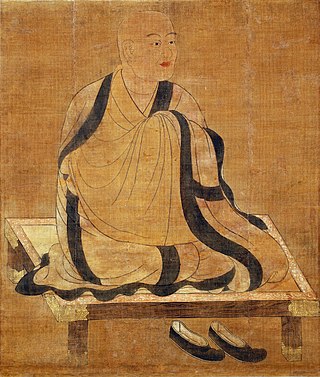
Yi Xing, born Zhang Sui, was a Chinese astronomer, Buddhist monk, inventor, mathematician, mechanical engineer, and philosopher during the Tang dynasty. His astronomical celestial globe featured a liquid-driven escapement, the first in a long tradition of Chinese astronomical clockworks.

The Constantinople observatory of Taqi ad-Din, founded in Constantinople by Taqi ad-Din Muhammad ibn Ma'ruf in 1577, was one of the largest astronomical observatories in medieval world. However, it only existed for a few years and was destroyed in 1580.

Astronomy in China has a long history stretching from the Shang dynasty, being refined over a period of more than 3,000 years. The ancient Chinese people have identified stars from 1300 BCE, as Chinese star names later categorized in the twenty-eight mansions have been found on oracle bones unearthed at Anyang, dating back to the mid-Shang dynasty. The core of the "mansion" system also took shape around this period, by the time of King Wu Ding.
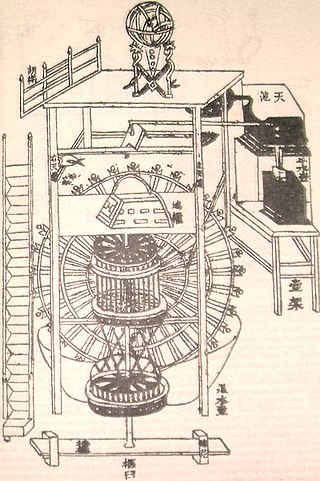
Su Song, courtesy name Zirong, was a Chinese polymathic scientist and statesman. Excelling in a variety of fields, he was accomplished in mathematics, astronomy, cartography, geography, horology, pharmacology, mineralogy, metallurgy, zoology, botany, mechanical engineering, hydraulic engineering, civil engineering, invention, art, poetry, philosophy, antiquities, and statesmanship during the Song dynasty (960–1279).

Indian astronomy refers to astronomy practiced in Indian subcontinent. It has a long history stretching from pre-historic to modern times. Some of the earliest roots of Indian astronomy can be dated to the period of Indus Valley civilisation or earlier. Astronomy later developed as a discipline of Vedanga, or one of the "auxiliary disciplines" associated with the study of the Vedas dating 1500 BCE or older. The oldest known text is the Vedanga Jyotisha, dated to 1400–1200 BCE.

Medieval Islamic astronomy comprises the astronomical developments made in the Islamic world, particularly during the Islamic Golden Age, and mostly written in the Arabic language. These developments mostly took place in the Middle East, Central Asia, Al-Andalus, and North Africa, and later in the Far East and India. It closely parallels the genesis of other Islamic sciences in its assimilation of foreign material and the amalgamation of the disparate elements of that material to create a science with Islamic characteristics. These included Greek, Sassanid, and Indian works in particular, which were translated and built upon.
Zhang Sixun was a Chinese astronomer and mechanical engineer from Bazhong, Sichuan during the early Song Dynasty. He is credited with creating an armillary sphere for his astronomical clock tower that employed the use of liquid mercury. The liquid mercury filled scoops of the waterwheel would rotate and thus provide the effect of an escapement mechanism in clockworks and allow the astronomical armillary sphere to rotate as needed.

An astrarium, also called a planetarium, is an ancient astronomical clock made in the 14th century by Italian engineer and astronomer Giovanni Dondi dell'Orologio. The Astrarium was modeled after the solar system and, in addition to counting time and representing calendar dates and holidays, showed how the planets moved around the celestial sphere in one timepiece. This was its main task, in comparison with the astronomical clock, the main task of which is the actual reading of time. A complex mechanism, it combined the functions of a modern planetarium, clock and calendar into a singular constructive device. Devices that perform this function were known to have been created prior to the design of Dondi, though relatively little is known about them. It is occasionally erroneously claimed by the details of some sources that the Astrarium was the first mechanical device showing the movements of the planets.

Ancient Chinese scientists and engineers made significant scientific innovations, findings and technological advances across various scientific disciplines including the natural sciences, engineering, medicine, military technology, mathematics, geology and astronomy.

The Globe of Gottorf is a 17th-century, large, walk-in globe of the Earth and the celestial sphere. It measures 3.1 meters in diameter. Conceived and constructed at Gottorf Castle near Schleswig, it was later transferred to the Kunstkamera museum in Saint Petersburg in Russia. Following a fire in 1747 most of the globe had to be reconstructed. A modern replica was constructed in 2005 at the original location near Schleswig.

The Tang dynasty (618–907) of ancient China witnessed many advancements in Chinese science and technology, with various developments in woodblock printing, timekeeping, mechanical engineering, medicine, and structural engineering.
Song I-yeong was a Korean court astronomer of the Joseon dynasty. He invented a weight-powered astronomical clock and contributed greatly to the implementation of the Shixian Calendar in Joseon. He also made systematic observations of two comets.
This is a bibliography of water clocks.
